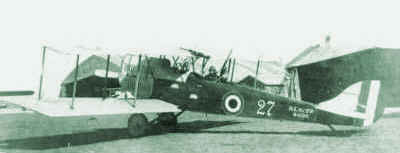 |
AIRCRAFTOF THEA E F |
SIA 7B1

Development and OperationThe SIA 7b was designed and produced by the Società Italiana Aviazione, the air branch of the Fiat company in Turin. It was tested in early 1917 and it was delivered to the reconnaissance squadrons since the summer of 1917. It was powered by a Fiat 12 engine developing 260 hp. A later version, powered by the 300 hp Fiat A 12bis, was called SIA 7b2, and had a different fairing of the fuselage decking. It was a very modern airplane, replacing the many pusher biplanes that formed the bulk of Italian reconnaissance, like the Caudron G.3, Farman 1914, Farman MFC and Savoia Pomilio SP.2 and SP.3. It was very fast and agile and it gained fame for some spectacular flights. On 15 August 1917 capt. Giulio Laureati flew from Turin to Naples and back, 1,000 miles, in 10 hours 30 minutes. Laureati again with engineer Tosa flew from Turin to London, 1,200 km, in just over 6 hours on 24 september 1917. In service, however, the type proved disappointing. Its workmanship was bad, and it suffered from wing failure, loosing its wings in flight. Also its engine was troublesome, suffering from backfire at the carburettor and catching fire. Progressively the Sia 7b equipped squadrons 22, 24, 26, 27, 28, 31, 32, 35, 36, 37, 38, 40, 112 and 121 of the Italian air force. The type suffered heavily from accidents and in the spring of 1918 a technical commission of Fiat visited all the SIA untis to try to solve the technical problems. Test pilot Francesco Brach Papa flew many airplanes and even flew war missions to restore confidence in the type. On June 24 1918 the loss of a SIA with the death of Group commander Ottorino Mutti was the final straw, and the SIA 7b was grounded, while SIA was excluded from the suppliers of the Italian air force. The name was abandoned, and later airplanes were called Fiat, like the Fiat R.2. This gorunding caused a crisis, and almost half Italian reconnaissance squadrons were disbanded, in the middle of the war. The US bought 19 Sia 7b, of which little is known. There are photos of them, with US roundels, at the Foggia flying school, but it is doubtful that they were much flown, if at all.The SIA 7b was designed and produced by the Società Italiana Aviazione, the air branch of the Fiat company in Turin. It was tested in early 1917 and it was delivered to the reconnaissance squadrons since the summer of 1917. It was powered by a Fiat 12 engine developing 260 hp. A later version, powered by the 300 hp Fiat A 12bis, was called SIA 7b2, and had a different fairing of the fuselage decking. It was a very modern airplane, replacing the many pusher biplanes that formed the bulk of Italian reconnaissance, like the Caudron G.3, Farman 1914, Farman MFC and Savoia Pomilio SP.2 and SP.3. It was very fast and agile and it gained fame for some spectacular flights. On 15 August 1917 capt. Giulio Laureati flew from Turin to Naples and back, 1,000 miles, in 10 hours 30 minutes. Laureati again with engineer Tosa flew from Turin to London, 1,200 km, in just over 6 hours on 24 september 1917. In service, however, the type proved disappointing. Its workmanship was bad, and it suffered from wing failure, loosing its wings in flight. Also its engine was troublesome, suffering from backfire at the carburettor and catching fire. Progressively the Sia 7b equipped squadrons 22, 24, 26, 27, 28, 31, 32, 35, 36, 37, 38, 40, 112 and 121 of the Italian air force. The type suffered heavily from accidents and in the spring of 1918 a technical commission of Fiat visited all the SIA untis to try to solve the technical problems. Test pilot Francesco Brach Papa flew many airplanes and even flew war missions to restore confidence in the type. On June 24 1918 the loss of a SIA with the death of Group commander Ottorino Mutti was the final straw, and the SIA 7b was grounded, while SIA was excluded from the suppliers of the Italian air force. The name was abandoned, and later airplanes were called Fiat, like the Fiat R.2. This gorunding caused a crisis, and almost half Italian reconnaissance squadrons were disbanded, in the middle of the war. The US bought 19 Sia 7b, of which little is known. There are photos of them, with US roundels, at the Foggia flying school, but it is doubtful that they were much flown, if at all. |
Aircraft and Flight Characteristics
|
Length: |
9,07 |
|
Height: |
3,15 |
|
Empty Weight |
1150 |
|
Loaded Weight |
1650 |
|
Maximum Speed |
175 |
|
Wing Span |
13,32 |
|
Ceiling |
5,000 |
|
Climb To 3,000 m |
17 min |
|
Endurance |
4 hours |
References:
- Official data Italian Air Force manuscript 1923 -
- Photo courtesy of Roberto Gentilli
To find other Doughboy Features visit our |
Membership Information  Click on Icon |
For further information on the events of 1914-1918
visit the homepage of |
Michael E. Hanlon (medwardh@hotmail.com) regarding content,
or toMike Iavarone (mikei01@execpc.com) regarding form and function.
Original artwork & copy; © 1998-2000, The Great War Society